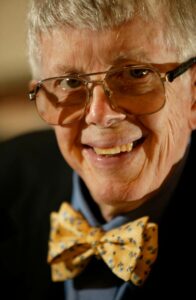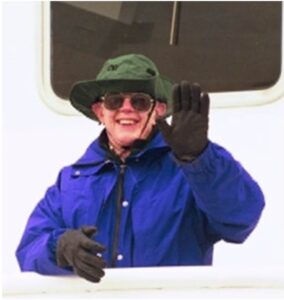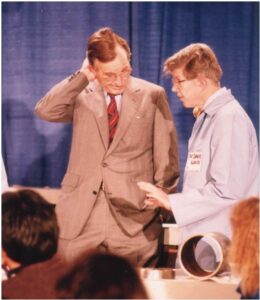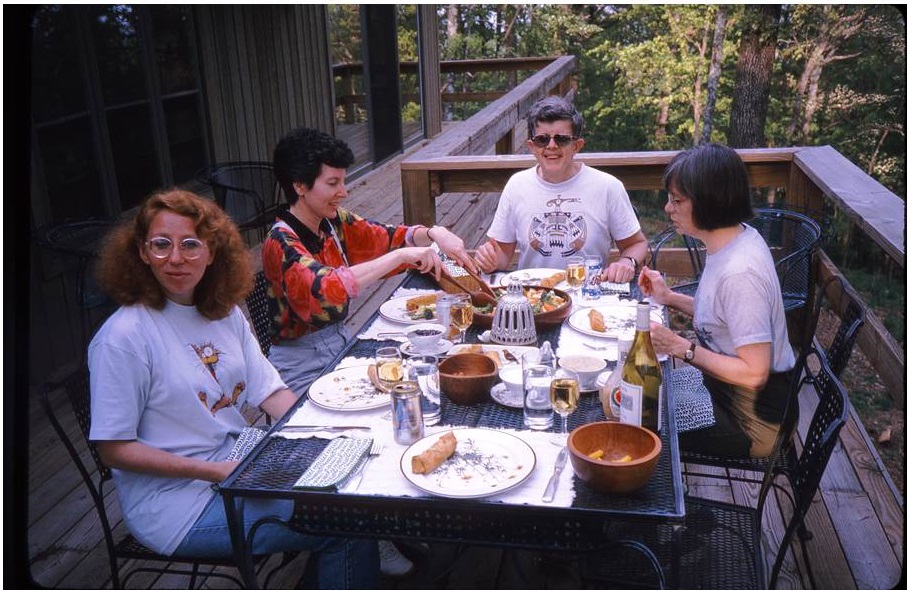David Cleaveland White, M.D., Ph.D.
 “Science is like a monastery where we work as replaceable unknowns on the manuscript that is the ever-deepening view of the majesty of interactions in this incredible universe.”
“Science is like a monastery where we work as replaceable unknowns on the manuscript that is the ever-deepening view of the majesty of interactions in this incredible universe.”
David C. White was a friend, colleague, scientific leader and a founding investigator of the former DOE Subsurface Science Program (SSP) who passed away October 25, 2006. David is survived by his wife Sandy, three children and ten grandchildren. David is remembered as an exciting, thought-provoking, altruistic mentor, the developer and leader in the field of lipid signature biomarkers, and a true leader in interdisciplinary science. David graduated from Dartmouth College in 1951 with majors in Chemistry and Geology and he completed an M.D. at Tufts University in 1955. After serving in the U.S. Navy Medical Corps, he earned a Ph.D. in Biochemistry from Rockefeller University. In 1972 he rose to a Professor of Biochemistry at the University of Kentucky Medical Center. He served as Professor in the Department of Biological Sciences and as Associate Director of the Program in Medical Sciences at Florida State University from 1973 to 1985. In 1986 David became a University of Tennessee (UT) and Oak Ridge National Laboratory Distinguished Scientist and Professor of Microbiology. From 2000 he was the Director of the UT Center of Biomarker Analysis. Decades before molecular biology tools were available his laboratory was monitoring cellular lipid constituents as indicators of biomass, viability, diversity, and metabolic capacity.
David’s early research focused on electron transport machinery. In the early 1960s, he and collaborators demonstrated cytochrome-based electron transport in a strict anaerobe, the discovery that hemes were required for its growth and roles for quinones. In 1967 he published his first paper on microbial fatty acids and the next 40 years brought, in his words, “…the power of quantitative analytical chemistry to microbial ecology.” Specifically, David developed and led the field of signature lipid biomarkers and trained many of the world’s lipid chemists. In 1972 David relocated from Kentucky to Florida State University (FSU), where he developed clinical studies for the Program in Medical Sciences. He established a free clinic in the basement of a church to treat patients suffering from diabetes and hypertension where first year medical students were exposed to clinical practices. While at FSU, David received the Winzler Award in 1977, 1978, 1979 and 1981 for outstanding teaching at the FSU Program in Medical Science. Student compliments included that David “…presented his knowledge as a precious gift rather than a burden to bear.” He also taught a popular non-major biology course with more than a thousand students, so large it was convened in the university opera house. At Tennessee, his lab expanded its ecological focus to include biofilms, corrosion, subsurface science, bioremediation and life in extreme environments. DC commented that, “no matter where I have looked on this planet, consortia of microbial life are scratching out a living by working together.” In later years, David’s research returned to the medical arena, where he pursued development of rapid methods for detecting indications of microbial infections using mass spectrometry, including analysis of breath.
“David White was pushing molecular microbial ecology (molecular biomarkers and signatures) before we could spell it”
1962: Cytochrome-linked fermentation in Bacteroides
1964: Vitamin K’s and new group of naphthoquinones
1967: Extraction and characterization of lipids
1970: Carotenoid formation by Staphylococcus aureus
1974: AA and e-transport in membrane vesicles
1975: Mitochondrial cytotoxicity of CO
1977: Muramic acid to measure estuarine biomass
1979: Phospholipids as biomass measures
1981: Microfouling of metals exposed to seawater
1983: Ground water and sediment microbiota
1985: FTIR spectroscopy for microbial ecology
1985: Microbial extraction of H2 from lunar dust
1986: Diatoms beneath Antarctic ice
1986: Lipid biomass in subsurface sediments
1988: DOE Subsurface Science studies
1997: Impact of rising CO2 on sediment microbiota
1997: Sensitive identification of Cryptosporidium
2005: Lipids in breath as harbingers of pathobiology
DC White provided service to many advisory committees, boards, or panels for the National Academy of Sciences, U.S. Navy, U.S. EPA, NSF, NASA, American Water Works Association, National Water Research Institute, and numerous programs for DOE. David also served on the Scientific Board of Inquiry at the Princeton Theological Seminary. He received DOE certificates of appreciation in 1986 and 1989 for his leadership in the Subsurface Science Program. David was a Fellow in the American Academy of Microbiology and the American Association for the Advancement of Science. In 1977 he received the U.S. EPA Scientific and Technological Achievement Award for pioneering lipid biomarkers. He was the recipient of the 1993 Proctor and Gamble Award in Applied and Environmental Microbiology as well as the 1995 Athalie Richardson Irvine Clarke Prize for the National Water Research Foundation. Typical of David, the monetary award from the Clarke Prize was donated for upgrading a mass spectrometer. Longtime collaborator David Ringelberg recalled DC White joking, “one day I’m going to line my driveway with mass specs.” Applying lipid interrogation tools to low biomass environmental samples, his laboratory could find evidence of microorganisms at densities as low as 1000’s of microorganisms per gram. The lipid methodologies DC White developed have stood the test of time for monitoring biomass and microbial community structure.
Several awards honor DC White. The David C. White Research and Training Award, is sponsored by the American Society for Microbiology (ASM), recognizing distinguished accomplishments in interdisciplinary research and training. The UT Department of Microbiology grants the David C. White Student Travel Award for the national ASM meeting. The International Society for Microbial Ecology presents the David C. White Most Innovative Student Poster Award. The David and Sandra White Faculty Award in Microbiology is designated for the UT Department of Microbiology.
DC White’s Most Cited Papers
- White, D.C., W.M. Davis, J.S. Nickels, J.D. King and R. J. Bobbie. 1979. Determination of the Sedimentary Microbial Biomass by Extractible Lipid Phosphate. Oecologia 40:51-62.
- Guckert, J.B., C.P. Antworth, P.D. Nichols, and D.C. White. 1985. Phospholipid, Ester-Linked Fatty Acid Profiles as Reproducible Assays for Changes in Prokaryotic Community Structure of Estuarine Sediments. FEMS Microbiol. Letters 31:147-158.
- Vestal, J.R., and D.C. White. 1989. Lipid Analysis in Microbial Ecology. Quantitative Approaches to the Study of Microbial Communities. Bioscience 39:535-541.
- Lovley, D.R., S.J. Giovannoni, D.C. White, J.E. Champine, E.J.P. Phillips, Y.A. Gorby, and S. Goodwin. 1992. Geobacter metallireducens gen.nov.sp. nov., A Microorganisms Capable of Coupling the Complete Oxidation of Organic Compounds to the Reduction of Iron and Other Metals. Arch. Microbiol. 159:336-344.
- Anderson, R.T., H.A. Vrionis, I. Ortiz-Bernad, C.T. Resch, A.D. Peacock, R. Dayvault, S. Marutzky, D.R. Metzler, K. Karp, M. Lowe, D.C. White, P.E. Long, and D.R. Lovely. 2003. Stimulating the in situ Activity of Geobacter Species to Remove Uranium from the Groundwater of a Uranium-Contaminated Aquifer. Applied and Environmental Microbiology 69:5884-5891.
–Tommy Phelps, ORNL-retired



